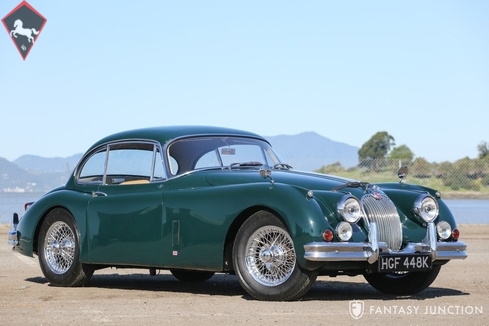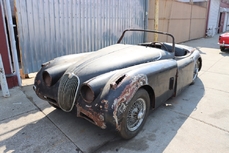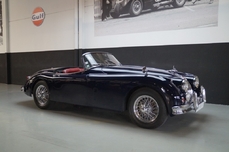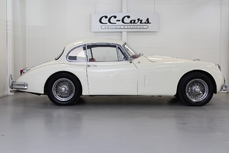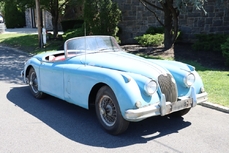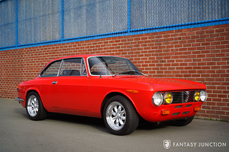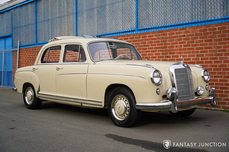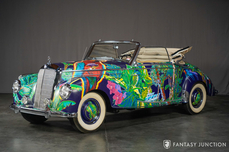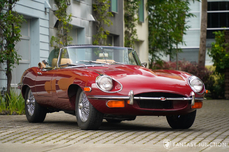Jaguar XK150 3.8 Liter Inline-6 1958
Allgemeine Beschreibung :
1958 Jaguar XK150 Fixed Head Coupe
s/n S 834796, engine no. R9042-9
British Racing Green with Biscuit Leather
The stunning XK120 put Jaguar on the map as one of the premier manufacturers of modern sports cars. The motoring public and press raved over the performance, presence, and value of these beautiful cars. As years evolved, revisions and improvements refined these cars into some of the finest sports cars available. The XK150 would become the final evolution of the much-lauded XK line, capping more than a decade of production that included five Le Mans wins, design awards, global sales success, and continuous media accolades. The XK150 featured an all-new and wider body, offering greater interior room, blended front and rear fenders and smoother body surfacing. Performance was enhanced with a variety of hotter engine options culminating with the triple carbureted 3.8 liter version. The XK150 not only offered performance excellence, the interior was offered with just the right amount of elegance to make it a refined road car.
In addition to the many improvements featured on the XK150, a smooth, one-piece wrap around windscreen, accented by a curvaceous side glass opening, delivered expansive visibility from the cockpit. The exterior was devoid of excess chrome other than the grille and fascia treatments and required bumpers. The clean and pure Fixed Head Coupe configuration was the perfect performance profile for anyone wanting a touring car with both refinement and a sporting nature. By 1958, disc brakes were added to the lineup and performance options including a higher horsepower “S” model, designated by a chrome plated S at the exterior forward corner of the doors.
According to records supplied by the current and previous owners, this handsome XK150 coupe was manufactured November 21, 1957, leaving the factory as a 3.4 litre powered car with engine number V 2132-8. Finished in Cream with red interior, the car was dispatched to Jaguar Cars, New York, NY on December 9, 1957 and first sold in January 1958. The car made its way to California relatively early in its life and still wears its black license plates dating from the late 1960s. Documents dating as far back as 1975 also support the car’s long-term California history. In 2006, the previous owner purchased the car as a restoration project, having been stored since 1991. Photos of the car at time of purchase show it as a largely original example still in its original cream on red color combination, sitting on chrome wire wheels and equipped with wood-rimmed Nardi steering wheel.
Beginning in 2006, under previous ownership, the car was treated to a comprehensive five-year restoration with the goal of making it a performance-based touring car that would deliver improved performance and reliability while leaving the fundamental character of the car intact. The car was disassembled, and all panels prepared for new paint. Having been in California, the frame and body panels were not subject to harsh conditions and were very sound prior to the restoration. The green paint was professionally applied, and chrome plating redone throughout the car. A 3.8 litre engine was selected, and rebuilt using an upgraded vibration dampener, higher compression ratio, and slightly more aggressive cams. The engine was outfitted with triple Weber carburetors and a specially cast intake manifold sourced from Pierce Manifolds was installed. The completed engine was mated to a new Classic Jaguar 5-speed transmission. As part of the build, a billet aluminum adapter plate was installed using Grade 8 fasteners, new CJ5 driveshaft, new CJ5 speedometer cable and drive gear, heavy duty 10” CJ5 clutch disc, polished billet scatter shield, and billet 5-speed gearshift knob. Jaguar trim specialists at BAS LTD supplied interior materials, reupholstered specific components in Biscuit leather and further finishing was performed including a new fawn headliner and new carpet. Upon completion, the car was trimmed with the distinctive “S” emblem on the upper door, signifying the performance theme of the original, with a nod to the modern upgrades.
Among the many features that were improved while the car was restored and upgraded to the new specifications, the owner installed 1/2” wider wire wheels, a new more efficient radiator with an electric cooling fan, an upgraded C-45 starter motor (itself a $1,000 expense), a new alternator (installed inside an original generator casing), polarity was switched to negative ground, stainless steel exhaust and headers installed, and a custom hidden sound system installed in the interior and trunk. In June 2019, the current owner performed a compression check confirming all cylinders at 170-180lbs. The Weber carburetors were removed and rebuilt, new fuel hose installed, a new fuel pump installed, coil wire replaced, a vacuum leak repaired, and the oil and filter changed. During the test drive after work was performed, mid-range throttle response was not ideal. New larger idle jets were installed, carbs reset, and ignition timing set to 38 degrees. The results have improved performance and throttle response. During this same period, the front wheels were removed and professionally balanced.
Today, this handsome XK150 presents in very good condition, having been enjoyably used over the years and properly maintained. The paint still retains a high gloss finish overall with some road use evident in the front area, some light swirl marks and other surface imperfections, and a few minor scuffs when viewed closely. Underneath the driver’s side S emblem there is some paint chipping and a few other areas showing minor chips particularly in the closure gaps. The panel fit is good throughout with very nice fit to the doors and trunk. The doors, hood, and trunk all open and shut with excellent fit and closure, with an homage to racing in the form of a leather strap across the forward hood section. The grill, trim, and window garnish molding are in excellent visual condition with no major scuffs or scratches, though the bumpers have some light hazing evident in some of the top surfaces. The lighting and lenses are beautifully finished. The car wears a set of chrome plated wire wheels showing no cub rash and excellent plating throughout. The car is shod with slightly wider Vredestein Sprint Classic tires with excellent tread remaining.
The interior leather surfaces are in excellent condition with no significant signs of wear on the seats or door panels, tight piping lines, and good seat support. The quality of the workmanship is generally excellent. Carpet is in good condition overall with minor edge wear at the doorsill trim and some light evidence of use in the driver’s foot-well and passenger area. The dashboard and surrounding door trim are beautifully finished with excellent fit to the leather and correct installation. The instruments in particular have been correctly restored still showing vivid color to the dial faces and very nice bright-work trim accenting the dashboard and instruments. The steering wheel is a handsomely finished wood rimmed accented with polished aluminum spokes and Jaguar horn button. Behind the seats, the rear compartment has been properly finished with correct materials and appears to have been only minimally used since the restoration was completed. In addition to the cohesive nature of the interior, the floor-shift 5-speed is perfectly integrated into the interior. Overall the interior is in excellent condition, showing just minor signs of thoughtful use since the restoration was completed, but notably still featuring beautiful chrome details including the delicate window hand levers, door handles, various trim, and the cleverly concealed modern radio tucked inside the driver’s side dashboard glove pocket. The trunk compartment is carpeted in matching interior material, housing the stereo unit, full sized tire and wire wheel as well as tools and jacking equipment.
The engine compartment is beautifully finished with proper polishing on the factory aluminum castings, correct gloss finishes on assorted black parts, and correct finishing on the inner fenders and firewall. While some time has passed since the restoration was completed and a few of the components have warmed a bit and lightly mellowed in finish, the evidence of excellence clearly shows in the finishes, correct fasteners, and attention to originality. Viewing the underside of the car, one clearly can see the attention to detail afforded during the restoration process as the underside is very nicely presented. And while there is evidence of road use, there are no visible signs of structural compromise, supporting the long-term California history and indicting appropriate care properly afforded by current and previous owners.
With a flip of key and just a moment’s pause for priming the Webers, the engine starts easily at the push of the starter button. Engine idle is smooth as operating temperature comes up, with good throttle response and oil pressure. The clutch engages easily as the car sets off smoothly and briskly as one might expect from enlarged 3.8 liter engine with triple Webers. The carburetors operate very well in the mid to upper revs as the car pulls hard on acceleration and the slightly hotter cams come on. Coupled with the well-judged ratios in the 5-speed gearbox, the car is genuinely swift and sounds superb, thanks especially to the velocity stacks. The gearchange has a modern mechanical, slick feel, with excellent synchromesh and a nice tall 5th gear for cruising at speed. This, coupled with the fixed head composure and confident disc brakes, delivers confidence with every mile. Braking is smooth and in keeping with technology of the period while road manners at highway speeds or leisurely cruising are particularly satisfying. The car comes with a tool roll and tools, correct jack, and mallet, an original owner’s manual, and selected ownership documents.
This handsome and wonderfully updated Jaguar XK150 Fixed Head Coupe embodies all the desirable advances of the original design, coupled with well-sorted and preferred performance mechanicals. Outfitted with disc brakes and Weber carburetion and ready for enjoyable driving, this XK150 is at home touring quaint roadways or open highways or in attendance at local shows and Jaguar club gatherings. This uniquely prepared XK150 will delight the next fortunate owner with elegant motoring pleasure and charm that only a vintage Jaguar can deliver.
https://fantasyjunction.com/inventory/1958-jaguar-xk150-fixed-head-coupe/overview
1958 Jaguar XK150 3.8 Liter Inline-6 is listed verkauft on ClassicDigest in Emeryville by Fantasy Junction for $75000.
Fakten der Auto
Karosserietyp : Auto Marke : Jaguar Modell : XK150 Ausführung : 3.8 Liter Inline-6 Hubraum : 3.8 Modelljahr : 1958 Lage : Emeryville Fahrzeug Anmeldung : Normal
Verkauft
Angaben Zum Verkäufer
Verkauft
People who viewed this Jaguar XK150 also viewed similar Jaguar listed at ClassicDigest
Other cars listed for sale by this dealer
über Jaguar
Ah, die Geschichte von Jaguar, von seinen Anfängen als SS Cars Ltd. bis hin zum Höhepunkt mit dem D-Typ und der Straßenversion des ikonischen E-Typs. An dieser Erzählung haftet etwas zutiefst Britisches, und ich werde sie erzählen, wie es ein britischer Journalist tun würde.Die Anfänge:
Unsere Reise in die Welt von Jaguar beginnt in den 1930er Jahren, als ein Unternehmen namens SS Cars Ltd. auftauchte. Trotz des unglücklichen Zufalls ihrer Initialen, die mit den aufkommenden politischen Spannungen in Europa zusammenfielen, begannen sie, stilvolle und leistungsorientierte Autos herzustellen. Der SS 100, der 1936 eingeführt wurde, war ein Symbol für Eleganz und Geschwindigkeit und legte den Grundstein für das, was Jaguar werden sollte.
Die Geburt von Jaguar:
Als der Schatten des Zweiten Weltkriegs näher rückte, entschied sich SS Cars Ltd. klugerweise, sich von den SS-Initialen zu distanzieren. So wurden sie 1945 offiziell zu Jaguar Cars Ltd., ein Name, der bald für britischen Luxus und Leistung stehen würde.
Die XK-Serie:
Die Nachkriegszeit von Jaguar brachte uns den XK 120, eine wahre Sensation im Jahr 1948. Mit seinem schlanken Design und einem leistungsstarken 3,4-Liter-Sechszylindermotor wurde er zum schnellsten Serienauto der Welt. Der XK 120 war die Blaupause für das, was kommen würde - Jaguars, die Stil mit Geschwindigkeit auf einzigartig britische Weise verbanden.
Die Dominanz des D-Typs:
Dann kam der D-Typ, eine wahre Rennlegende. 1954 eingeführt, gewann er in den 1950er Jahren dreimal Le Mans und zeigte die technische Kompetenz von Jaguar. Mit seiner innovativen Monocoque-Konstruktion und der ikonischen Finne hinten war der D-Typ der Höhepunkt von Jaguars Motorsporterfolgen.
Das Auftauchen des E-Typs:
Aber der wahre Wendepunkt kam 1961 mit der Einführung des E-Typs, oft von Enzo Ferrari als "das schönste Auto, das je gebaut wurde" bezeichnet. Seine lange Motorhaube, die geschwungene Karosserie und ein 3,8-Liter-Motor, der atemberaubende Leistung lieferte, machten ihn sofort zu einem Klassiker. Der E-Typ war nicht nur ein Auto; er war ein Kunstwerk auf Rädern und konnte auf der Straße 150 Meilen pro Stunde erreichen.
Straßen- und Rennsporterfolge:
Die Schönheit des E-Typs wurde durch seine Leistung auf der Rennstrecke unterstrichen. Die leichten E-Typen waren bei verschiedenen Rennveranstaltungen besonders erfolgreich und festigten den Ruf von Jaguar als eine Kraft, mit der man im Motorsport rechnen musste.
Das Zeitalter der Raffinesse:
Je tiefer wir in die Geschichte von Jaguar eintauchen, desto mehr erkennen wir, dass die 1950er und 1960er Jahre ein Zeitalter der Raffinesse und Expansion waren. Neben dem großartigen D-Typ und dem ikonischen Aufstieg des E-Typs führte Jaguar Modelle ein, die seinen Ruf für Luxus und Leistung weiter festigten.
Der MK2:
Ende der 1950er Jahre stellte Jaguar den MK2 vor, eine Sportlimousine, die Eleganz mit Leistung vereinte. Diese elegante viertürige Limousine war sowohl bei Bankräubern als auch bei der Polizei aufgrund ihrer außergewöhnlichen Geschwindigkeit und Handhabung beliebt. Der MK2 war ein Symbol für Jaguars Fähigkeit, Raffinesse mit Leistung zu verbinden und hatte auch eine erfolgreiche Rennkarriere.
Der XJ6:
Springen wir ins Jahr 1968, als Jaguar ein Auto auf den Markt brachte, das Jahrzehnte lang Luxuslimousinen definieren würde - den XJ6. Es war ein Meisterwerk der Ingenieurkunst und des Designs, mit einem sanften Reihensechszylindermotor, unabhängiger Hinterachse und einem geräumigen, wunderschön ausgestatteten Innenraum. Der XJ6 war ein Symbol britischer Eleganz und bot eine so sanfte Fahrt, dass es schien, als würde er förmlich über die Straße gleiten. Er wurde zum Flaggschiffmodell für Jaguar und setzte den Maßstab für Luxuslimousinen und zeigte ein Maß an Raffinesse, das die Konkurrenz staunen ließ.
Die Verschmelzung von Klassik und Moderne:
Während der MK2 und der XJ6 die Evolution der Limousinen von Jaguar repräsentierten, bewahrten sie das Engagement der Marke für Leistung und Luxus. Diese Autos gehörten nicht nur auf die Rennstrecke; sie fühlten sich genauso wohl auf den Prachtstraßen wie auf einer entspannten Fahrt durch die englische Landschaft.
Die Herausforderungen des Wandels:
Dennoch sah sich Jaguar mit dem Eintritt der 1970er Jahre, wie viele britische Automobilhersteller, finanziellen Herausforderungen und Veränderungen in der Eigentümerschaft gegenüber. Die Ära von British Leyland brachte sowohl Chancen als auch Schwierigkeiten mit sich, während die Marke durch verschiedene Fusionen und Übergänge navigierte.
Das Erbe des MK2 und des XJ6, zusammen mit dem D-Typ und dem E-Typ, definiert Jaguar weiterhin als einen Hersteller, der zeitlose Eleganz mit einer Leistungsstärke vereint. Diese klassischen Modelle, ob sie über kurvige Straßen gefahren oder als Sammlerschätze geparkt werden, dienen als Zeugnis für die anhaltende Präsenz von Jaguar in der Welt der automobilen Exzellenz.
Die Jaguar-Geschichte, von ihren Anfängen als SS Cars Ltd. bis zur Schaffung von Automobilikonen wie dem E-Typ, dem MK2 und dem XJ6, ist eine Reise, die das Wesen des britischen Automobilbaus widerspiegelt - eine Mischung aus Luxus, Leistung und Stil, die nach wie vor Enthusiasten und Kenner gleichermaßen fasziniert.
